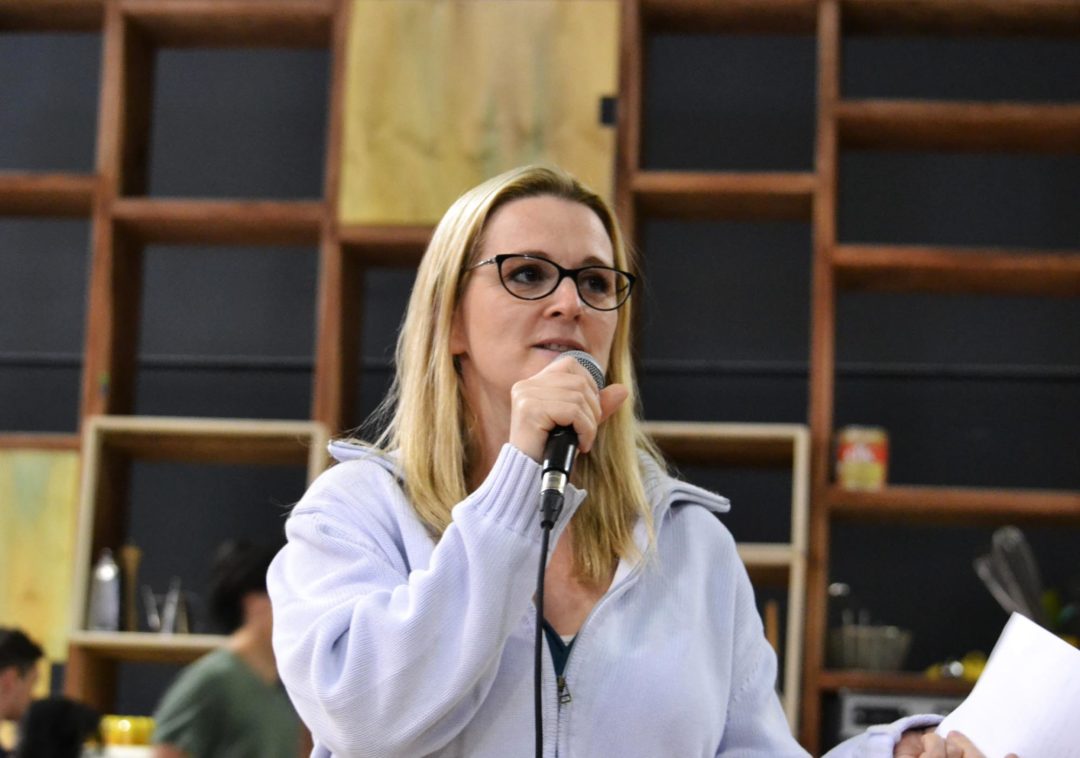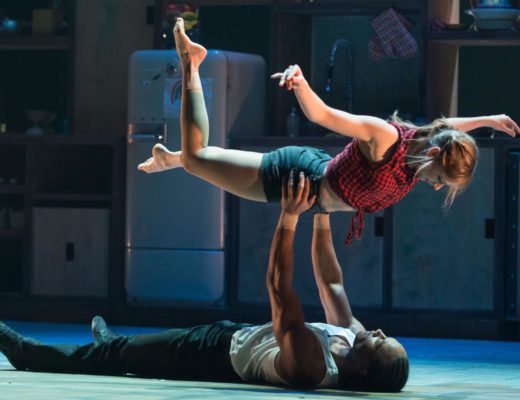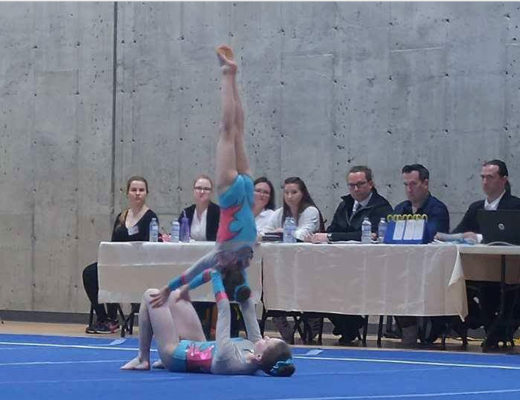Better-Lemons and I had the opportunity to chat with Shana Carroll, the co-founding artistic director of The 7 Fingers. We touched on The 7 Fingers’ beginnings from Cirque du Soleil, some of her and her husband Sébastien Soldevila’s most memorable creative moments, and, of course, CUISINE & CONFESSIONS.
What inspired you to create CUISINE & CONFESSIONS?
My husband and I co-created the show. Prior to creation, we were in our own kitchen, brainstorming on possible themes for the show. He was cooking as we were speaking — he is incredibly passionate about food, cooking — so I looked at him and said, “What if we do a cooking show?” We laughed, wondered if that was even possible, to cook on stage, to combine circus and cooking. I remembered a book my grandmother wrote called Young and Hungry. It was a memoir and a cookbook, marrying recipes from her childhood with accompanying anecdotes. I thought this could be an interesting approach for our show. So often, our shows have these strong autobiographical angles, as it’s a big part of the vision of our company to humanize the acrobatics, to ensure the audience really gets to know the performers and care about them. So, we thought of this notion of food memories: combining confession-like moments of storytelling, both physical and verbal, with childhood recipes.
Acrobats and dancers are not known for indulging in sweets or desserts. Do you all work out so much that you can eat whatever you want?
Hmmm… I can’t say I notice any across-the-board difference in an acrobat’s approach to food. It is true that the physical work is so intense that there is less “weight-watching,” and more assuring their bodies get enough sustenance to do what they need to do. There are peculiar things of timing — very hard to eat before the show, which is often standard dinner time. So they tend to eat large meals very late at night. But other than that, I would say their relationship with food is, in general, just like non-acrobats.
What can your audience expect to experience in CUISINE & CONFESSIONS?
It was interesting, when we created the show, we began with intense storytelling sessions with the cast. They went up, one by one, took the microphone and told extensive biographies of their parents, grandparents, linking them to food memories, etc. It just happened, with this particular cast, there were so many really tragic stories! Many of them had lost one or more of their parents, had grown up in harsh environments… We really wanted to share these intense stories, but it’s true at one moment I thought: My god! This show is gonna be a downer! Partly for that reason, we put a lot of effort on also capturing the joy and beauty and humor and love that also characterize our kitchen memories, and our joy and love of food and cooking… In the end, I find the overall tone of the show is quite light, joyful, playful; but embedded within are these very deep, intense stories that sometimes catch you off guard, and (without revealing too much!) make you contemplate some more pertinent social and political issues.
Also I’d add, circus is, by nature, celebratory, empowering, even triumphant. By its very nature: we are attempting to do seemingly impossible “tricks,” and then (hopefully :)) succeeding! So that is inevitably a factor, and theme, as well: the life-affirming power of circus.
 You co-founded Les 7 Doigts de la Main in 2002 in Montreal after seven years as Cirque du Soleil’s original solo trapeze artist in SALTIMBANCO. Were all seven of you (Isabelle Chassé, Patrick Léonard, Faon Shane, Gypsy Snider, Sébastien Soldevila and Samuel Tétreault) originally members of Cirque du Soleil at one time or another?
You co-founded Les 7 Doigts de la Main in 2002 in Montreal after seven years as Cirque du Soleil’s original solo trapeze artist in SALTIMBANCO. Were all seven of you (Isabelle Chassé, Patrick Léonard, Faon Shane, Gypsy Snider, Sébastien Soldevila and Samuel Tétreault) originally members of Cirque du Soleil at one time or another?
Yes, all seven of us at some point worked at Cirque du Soleil, for varying durations. Faon and Isabelle, for instance, began performing there when they were children! (At the time we founded the company, Faon was the artist to have worked longest at Cirque du Soleil, having started at the company’s inception as a young child). However, some of the “Fingers” I originally knew more through my years at circus school, or in the case of Gypsy; we were childhood friends from San Francisco. (I started at Pickle Family Circus, and she is the daughter of the founders.)
You performed with San Francisco’s Pickle Family Circus when you were 18 years old. What initially got you interested in performing?
I was a theatre kid, and at the age of 18 wanted to pursue an acting/directing career. My father was a columnist at the San Francisco Chronicle, and he wrote a book on the Pickle Family Circus, and subsequently, became quite involved with them, was on their board of directors, etc. He had been encouraging me for awhile to come check it out, but I was a serious theatre kid. 🙂 However, I did need a day job while I was pursuing acting and, again he suggested I work at the office at Pickles. At least it was arts-oriented, and I would learn valuable lessons about administration, non-profit, etc. But then I walked into work and saw a trapeze artist 15 feet away from me and everything changed on a dime. I instantly fell in love with it, abandoned everything else and said, “That’s what I’m gonna do!” It was certain in my mind; there was no turning back.
What type of technique classes did you first take – Ballet? Gymnastics? Trapeze?
As I mentioned, I did mostly theatre. Within my various theatre programs, I had some minimal movement classes, stage combat etc., and I tap danced for many years as well, but other than that was completely un-physical. I couldn’t touch my toes, or do a pull-up, when I first decided I wanted to do trapeze. For everyone who knew me, it was the most shocking and incongruous career choice. But I was so passionate and driven about trapeze, I just trained and trained and trained sometimes not really knowing what I was doing! I left my office job at Pickles to become an apprentice. Paid $300 a month to basically do whatever it is they decide they need you to do, on stage and off (often jumping on the other end of the teeterboard while other people flip into the air), but you get to learn alongside them, in every respect. How to tie knots, how to set up bleachers, how to stretch, tumble, sell t-shirts… I set-up a mini-trapeze off the boom of the bleacher truck and would just play around on it until it was too dark to see anything. That’s pretty much how I learned.
When did you decide you wanted to be a choreographer?
Well, it was funny that kind of came by accident before I really understood what choreographing was. I think because I came from theatre, and that it was the artistic qualities of trapeze that drew me to it. From the start, my main interest was in creating pieces, finding arcs and characters and storylines, alongside learning the tricks. When I got to National Circus School in Montreal (when I was 20), I discovered this was more of a rare thing, and I started creating acts for the other kids at school. There was our end-of-the-year show, my first year at school, and for that one year, it was student-directed. I was on the “choreography” team. I ended up choreographing 90% of the show, and realized this was something I loved. So I always tried to maintain that side of my creativity. When I was at Cirque, I was hired also as Dance Captain, so was in charge of maintaining all the choreography in the show. Sometimes, if there were new numbers joining the tour, I got to choreograph them. Then I would do little side projects, cabarets and things, to have the chance to create new pieces. So by the time I left Cirque to start The 7 Fingers (at 30 years old), choreographing had begun to eclipse trapeze as my main passion.
 Do most of the troupe have ballet training, as well as acrobatic?
Do most of the troupe have ballet training, as well as acrobatic?
Most of the cast went to circus school. Professional circus schools, particularly the one in Montreal, have very good dance programs the students are required to take. It is, of course, only for a couple years and not every day. But since it is so similar to acrobatics — physical expression — they tend to assimilate the dance very quickly. Because, in school, a circus artist is working towards creating one act, quite often their dance vocabulary is really individuated and limited. They are very expressive in one certain manner, but would have a hard time walking into dance class and just picking up a choreography.
Jumping through square frames is quite impressive. Does looking at common-day objects inspire you to think up interesting visual challenges?
Yes, definitely! It’s one of my favorite exercises, I even have my students do it when I teach. I tell them to just look around and find ten items and then brainstorm on how they could use them creatively/acrobatically.
What would a typical pre-show warm-up be for The 7 Fingers?
Actually the warm-up time for CUISINE & CONFESSIONS is fantastic! They need to stretch and warm up certain tricks, also play around with each other to relax and bond and get centered. AND they have to cut vegetables and grate cheese and preset all of their props and food items. It’s so great to watch people tumble and chop just inches away from each other, alternating which activity they’re doing!
The 7 Fingers have performed all over the world? Would you share a memorable story you remember from some of your many cities you visited.
For me, my most memorable moment was when we performed in Wellington, New Zealand. It was with our first show LOFT, which I was still performing in. We did our final bow and then the audience broke out into a “Haka,” the traditional Maori tribal dance they do. It’s like a kind of percussive war cry, but also used to show appreciation. So we were just standing there on stage and then, suddenly it was like the audience was performing for us. So much energy. And it went on and on, tears just streaming down our faces… incredible!
 Do you gear or tweak your show according to your different regions or nationalities of your audiences?
Do you gear or tweak your show according to your different regions or nationalities of your audiences?
Yes. Well, most of all, we always try to perform in the local language. In the case of CUISINE, we’re fortunate as the cast combined speaks about eight different languages, so we can reorganize who says what lines. And the others study the lines they have. It is quite a feat — we even performed the whole show in Russian — but really worth it. Also, there are small jokes here and there we try to adapt to the cultures we’re in.
In 2014, your husband Sébastien staged one of the three scenes of the Sochi Olympic Opening Ceremony. How much of his creation excitement did you get to experience? It must have been pretty spectacular, yes?
I was involved in the initial stages of creation of Sochi, so it was a great deal of fun, brainstorming and attending those meetings. When it came time to the on-site creation, Séb went to Sochi alone (I was involved in another project then), though I was brought over for one week just before the opening to tweak. It was exciting!
How did that feeling compare to you choreographing a number for the 2012 Oscars?
Oh, the Oscars was maybe one of the best memories of my life! It was just so much fun, and such a great team. I can’t even express what a fantastic memory that was. One of the moments that stuck with me… When our number was going to perform, they brought me to watch from the centre “island” where all the cameras are. When the performance was finished, one of the cameramen in the aisles high-fived me. It was kind of surreal.
How about for choreographing Cirque du Soleil’s IRIS in 2011?
IRIS was also a great experience. Actually, I think what was most special for me about IRIS was the chance to live in Los Angeles again. I grew up in Northern California, but after the divorce, my dad lived in Santa Monica for many years. So they did the joint custody thing, and I had a double life down there. I had a strong sentimental attachment to LA, but hadn’t really been back. So living there for four months, with my 2-year-old daughter, and so close to family, was just wonderful.
Your troupe must be a close-knit family, always being able to second-guess every move, every jump, every catch. How did the idea of living together in a renovated convent in Montreal come about?
Well, we all reached the same point in our lives at the same time: wanting to settle down, grow roots, have families, tour less. We all were hitting our thirties, and the nomadic life-style was starting to wear thin (which was incidentally also one of the reasons we founded the company). So we were all looking to buy a house at the same time in Montreal. Patrick found this crazy convent and had the idea we could all buy it together, renovate, live communally etc. Now we spend so much time together, between company and home, that we live less “communally” and more like very, very close neighbors. It’s really great for the kids, they have this crazy fluid expanse of houses they can run through, neighbors that are like siblings.
Aside from leaving The Broad Stage with a tasty morsels of banana bread in their stomachs and banana bread crumbs on their hands, what feelings would you want your audience to leave with?
To feel transformed! That it was cathartic. That they cried, and laughed, and ooh-ed, and aah-ed, and got to know these nine people like new nine best friends that they will remember forever! That they will think about their own food memories, their own parents. That they will go home and cook a family dinner, call their parents, share with their children some childhood memory. That they will decide to go swing on a trapeze or whatever risk-taking life-affirming equivalent, having had the glimpse that anything truly is possible if you just work hard enough, care enough, put enough soul into it. That they leave a little more hopeful, hearts (and bellies!) full.
Merci beaucoup, Shana! I look forward to tasting your banana bread and being wowed by The 7 Fingers’ acrobatic visuals.




No Comments